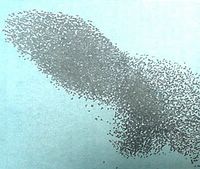
The miracle of community; birds flocking

As a new school year begins the question arises, ‘How does a school develop a learning community so powerful that all involved can act spontaneously within an agreed philosophy?’
For the past decade or so schools have been too busy, sidetracked trying to implement imposed technocratic curriculums and accountability demands, to consider a more effective way of working, that of being a ‘learning community’.
And, in turn, teachers have become so obsessed with complying with requirements that they too have neglected the real source of power – shared beliefs that they and their students forge through working together for their mutual benefit.
Flocks of birds and school of fish, and many other animals, have not lost this primal power! They could teach us a lesson about collective thinking.
It is obvious that teaching and learning are strengthened when teachers form a strong professional community and more so when they align themselves with other schools and organizations that are working in a similar ‘organic’ way.
To create such a professional learning community, schools need to have the courage to collectively question ineffective teaching practices and examine new conceptions of learning. It is through this process that they will generate ideas to support one another’s collective growth.
How do new teaching practices come to be known, shared and developed?
How do teachers develop a collective identity?
What conditions are needed to ensure teachers continually engage in ongoing professional work together because it is simply the best thing to do?
This is more than being handed out a vision and beliefs developed by others or agreed to by default.
Norms of isolation, tradition, habit, competition, and privatization of ideas need to be replaced by new understandings and by the lure of innovation, creation and being part of something exciting and worthwhile. Sharing each others teaching stories, successes and failures, and searching out common elements is part of this collective sense making process. To achieve this means being open and honest with ourselves and each other so as to give away defensive habits that create barriers to collective learning. This is not easy and requires leadership and support.
Once new conceptions have been identified new possibilities will emerge. From these beginning a new sense of being part of a learning community evolves. People then feel free to express uncertainties and dilemmas and are open to new ideas.
Attractive ideas will ‘gel’ together. When these are formalized they in turn act as a self reference for everyone’s actions. New ideas spread by themselves as if an epidemic. Wrong directions equally are seen as learning opportunities. Everything is learning. Everything is feedback and everything contributes to self correction.
Schools learn to fly as if flock of birds.
1 comment:
Reckon whitebait would as good a metaphor as birds.Good stuff.
Post a Comment